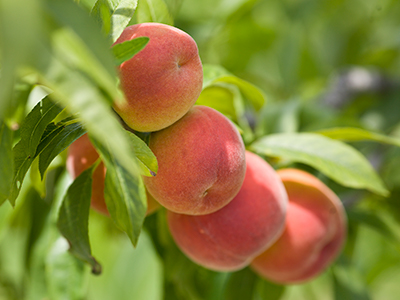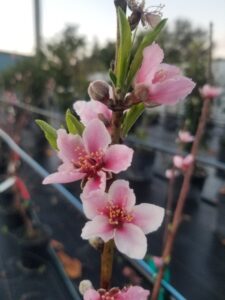By: Anna Stubbendick, FCHP
If you’re looking for a fruit tree that is easy to grow and produces delicious fruit, then a Florida peach tree might be just what you need! At Canterbury Farms Nursery & Garden Center, we offer a variety of Florida peach trees that are perfect for growing in the Sunshine State.
Florida Peach Varieties

Juicy Florida peaches can be a delicious home-grown treat in the spring season. ©Photo by Tyler Jones, UF/IFAS
There are several varieties of peach trees that grow well in Florida. Varieties that are typically carried at Canterbury Farms include Florida Grande, Florida Prince, Tropic Beauty, Tropic Prince, Tropic Snow, and Tropic Sweet. These cultivars are chosen because they have lower chill hours requirements than other varieties. (Read on for more information about chill hours.)
- Florda Grande peaches are a popular variety that produces large, juicy fruit with a deep orange color. The trees are vigorous and can grow up to 20 feet tall.
- Florda Prince peaches are a slightly smaller variety, but they are still very flavorful. They are known for their sweet taste and firm texture.
- Tropic Beauty peaches are a newer variety that is gaining popularity in Florida. They produce medium-sized fruit that is sweet and juicy.
- Tropic Prince peaches are similar to Florida Prince, but they are more disease-resistant. They produce firm, juicy fruit that is perfect for eating fresh or cooking.
- Tropic Snow peaches are a unique variety that produces white-fleshed fruit. They have a sweet, mild flavor and are great for eating fresh or using in desserts.
- Tropic Sweet peaches are a newer variety that is known for its extremely sweet fruit. The peaches are medium-sized and have a firm texture.
Florida vs. Georgia Peaches
One of the biggest differences between Florida and Georgia peaches is the growing season. Georgia peaches are typically harvested in May and June, while Florida peaches are harvested from late March to early May. Florida peaches also tend to be smaller than Georgia peaches, but they are just as sweet and flavorful.
Another difference is that Florida peach trees require less chill hours than Georgia peach trees. Florida peach trees only require around 100-500 chill hours, while Georgia peach trees require 800-1000 chill hours.
Why are Chill Hours Important?
Chill hours refer to the amount of time during the winter months when temperatures fall between 32°F and 45°F. During this period, deciduous fruit trees such as peaches, apples, and pears go into a dormant state. This dormant period is important for the trees because it allows them to accumulate the energy they need to produce fruit during the growing season.
In Florida, where winters are milder than in other parts of the country, peach trees require a certain number of chill hours to break their dormancy and produce fruit. If the tree doesn’t receive enough chill hours, it may not produce fruit, or the fruit may be of lower quality. On the other hand, if the tree receives too many chill hours, it may break dormancy too early, and the blossoms may be killed by late frosts.
The chill hour requirements for peach trees can vary depending on the cultivar, with some requiring as few as 100-200 hours, while others may need up to 500 hours. It’s important to select a peach tree variety that matches the chill hour requirements for your area to ensure optimal growth and fruit production.
By paying attention to the chill hour requirements of your peach trees, you can help ensure a bountiful harvest of delicious, juicy peaches year after year.
Planting and Growing Florida Peach Trees

Peach blossoms appear in early spring before the tree grows new leaves. ©Photo by Anna Stubbendick, Canterbury Farms
Ideally, peach trees should be planted during the dormant season, either in the late fall or early spring, when the weather is cooler and there is less stress on the tree. Planting during the dormant season allows the tree to establish its root system and prepare for the upcoming growing season. Planting a peach tree during the growing season, especially during the summer months, can put stress on the young tree and negatively impact its growth and survival. This is because the hot and dry conditions during the summer can cause the tree to lose more water through transpiration than it can absorb through its roots, which can lead to wilting, leaf drop, and even death. If you must plant a peach tree during the growing season, it’s important to take extra care to ensure that the tree receives enough water and is protected from direct sunlight and heat. Be sure to water the tree regularly, providing enough water to keep the soil moist but not waterlogged. Mulching around the base of the tree can also help to conserve moisture and regulate soil temperature.
When planting a Florida peach tree, it’s important to choose a site that receives full sun and has well-draining soil. To plant your peach tree, dig a hole that is twice the size of the tree’s root ball and backfill it with a mixture of soil and compost. Water the tree thoroughly after planting. Once the tree is established, it will require regular watering and fertilization. Water the tree deeply once a week, and fertilize it in the spring and summer with a balanced fertilizer. Prune the tree in the winter to remove any dead or diseased wood, and to shape the tree.
In conclusion, Florida peach trees are a great addition to any garden or orchard. With so many delicious varieties to choose from, you’re sure to find one that suits your tastes. If you’re interested in growing a Florida peach tree, visit Canterbury Farms Nursery & Garden Center for all your gardening needs!
| Variety | Mature Tree Size | Fruit Size | Fruit Color | Flavor | Texture | Chill Hours |
|---|---|---|---|---|---|---|
| Florda Grande | Up to 20 feet | Large | Deep orange | Sweet | Juicy | 150-200 |
| Florda Prince | Up to 15 feet | Medium | Orange-red | Sweet | Firm | 150-200 |
| Tropic Beauty | Up to 12 feet | Medium | Red-blushed | Sweet | Juicy | 100-200 |
| Tropic Prince | Up to 15 feet | Medium | Orange-red | Sweet | Firm | 100-200 |
| Tropic Snow | Up to 12 feet | Medium | White | Mildly sweet | Juicy | 150-200 |
| Tropic Sweet | Up to 15 feet | Medium | Orange-red | Extremely sweet | Firm | 100-200 |
Notes: Chill hour requirements may vary depending on the specific cultivar and location. The sizes listed above are approximate and may vary depending on growing conditions.
For more information, check out this Fact Sheet from the UF/IFAS Extension or visit their Gardening Solutions page.
